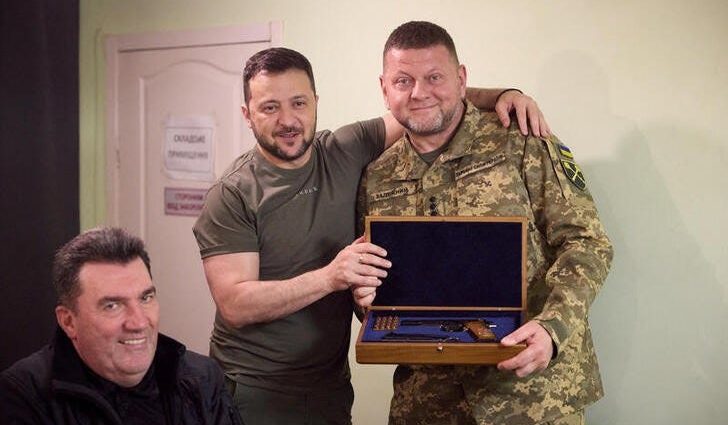The Russian Defense Ministry has reported that on the evening of July 28, Russia attacked a Ukrainian command post in Dnipro (Dnepropetrovsk) with “precision weapons” after Ukraine launched an attack on a Russian command post in Taganrog in Russia’s Rostov oblast (province).
According to the Russians, the incoming missile was shot down but it crashed into buildings in the town, including an art museum. The weapon used by Ukraine was a converted S-200 air defense missile reconfigured against ground targets.
A day earlier, on the 28th, Ukrainian President Volodymir Zelensky visited Dnipro where he presented an award to Ukrainian Commander in Chief Valerii Zaluzhny and met with a number of Ukrainian commanders including Colonel General Oleksandr Syrskyi and the chief of military intelligence, Kyrylo Budanov.

Zelensky is closely tracked by Russian intelligence. Thus his arrival in Dnipro and meeting with Ukrainian generals and field commanders as well as Ukraine’s military intelligence chief could have tipped off the location of the command center in Dnipro.
The Ukrainian press has suggested that the target of the Russian attack was a nearby apartment complex. However, some observers think the apartment complex was collateral damage caused by a Ukrainian air defense missile that crashed.
There are some videos circulating and photos that show some of the damage and it appears likely that the Russians hit the command post. The full extent of the casualties is not known. Reports say that some people are buried under the debris. The local hospital has put out a call for blood donors, suggesting the number of casualties is quite high.
There is no information yet whether any Ukrainian commanders were actually in the building when it was hit or, if so, any of them were casualties from the strike.
Targets in Russia
The war outside of Ukraine’s borders is spreading as Ukraine goes after targets on Russian territory. This past week the Ukrainians launched another drone attack aimed at Moscow, which the Russians say they shot down (although it caused damage on the ground).
However, the Taganrog attack was the most significant from the Russian point of view as it was aimed at the military command structure and at a location where General Valery Gerasimov and other military leaders previously gathered. Whether the Ukrainians had special intelligence for the July 28th attack on the location of Russia’s top brass we do not know, nor do we know if any Russian commanders were hit in the attack by the Ukrainians.
Meanwhile the Ukrainian offensive is continuing and is proving costly to both sides, but with Ukraine suffering the higher level of losses. This offensive, planned mainly by US and British special operators, seeks to overwhelm Russian defenses by brute force. Ukraine has made some modest gains, although these are often rolled back by the Russians.
The Russians have noted that Ukraine is using its best trained and most experienced troops and are operating with a high level of professionalism. These forces were NATO-trained and appear to have high morale. However, attriting your army’s best forces, with little of strategic value to show for the effort, in the end could force the Ukrainian government into reevaluating the war effort.
There is also growing concern in Washington that the war may soon spill over outside of Ukraine, with Poland high on the list as a possible hot spot. Both the Poles and the Russians have been actively provocative, with the Wagner forces moving into Belarus and with Poland sending armor resources to the borders of Belarus and Ukraine.
NATO is in a very bad position to support a widened war in Europe. It lacks troops (the US is now calling up reservists for US deployments in Eastern Europe) and sufficient ammunition, and NATO is very thin on air defenses and armor.
The Russians are also on the cusp of a major mobilization, something that presages the possibility of a wider conflict. Do you mean //Nor have the Russians continued to mince words about the “Ukraine Special Military Opertion. They now come right out and refer to it as Russia’s war against NATO. Nor do the Russians any longer mince words about the “Ukraine special military operation,” which is now characterized as Russia’s war against NATO.
In short the conflict is inexorably morphing and could soon go out of control from the point of view of confining it mainly to a battle on Ukrainian territory. This is underlined by the volunteers fighting in Ukraine, many of whom are Poles, and the attachment of American and British specialists to Ukrainian battlegroups.
Europe is simply unprepared for a war that might be fought on its territory. Few steps are being taken to try and head off a bigger crisis.
Stephen Bryen is a senior fellow at the Center for Security Policy and the Yorktown Institute. This article was originally published on Weapons and Strategy, his Substack. Asia Times is republishing it with permission.

